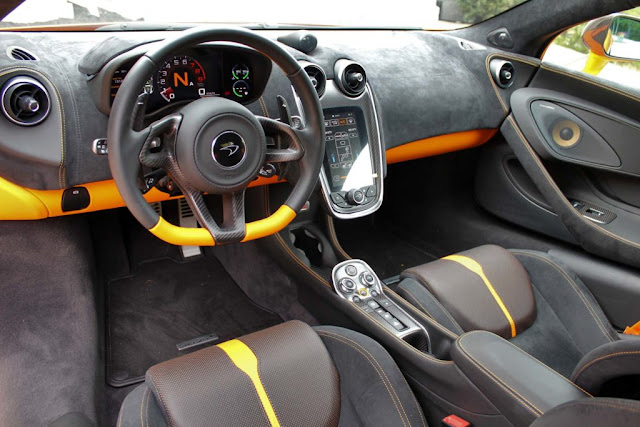The Nissan Pathfinder (Platinum model shown) gets major
upgrades for 2017, including new front and rear styling and a
more powerful V6 engine.
CARMEL, CA: Nissan’s Pathfinder is getting a number of changes for the 2017 model year.
Now in its fourth generation, Pathfinder falls somewhere between the mid-size
Muranoand the full-size Armada.
With an EPA interior volume listed as 4,468 litres (157.8 cu ft) that’s full-size to me,
but Nissan prefers to call it a “large” CUV.
Either way, the Pathfinder offers its EX Flex Seating system for seven with a
three-seat second row 60/40 split/fold bench and a two/seat 50/50 split/fold bench third row.
Lift a handle on the second row seat and the seat back tilts forward and the
cushion tilts up so it can slide forward for a claimed best in class access to the third row.
Also available is a power liftgate, which opens when a kicking motion is made under the rear bumper.
Introduced as a 2013 model, Nissan thought it was time to harden up the exterior
styling to make it more rugged looking with an entirely new front end incorporating the “V Motion”
grille design and a reshaping of the rear with a new bumper/rear panels and new taillights.
In the process, Nissan lowered the Cd to 0.326 from 0.34 on the outgoing model.
The 3.5-litre DOHC V6 now has direct injection, raising the power to 284 hp and 259 lb/ft
of torque up from 260 hp and 240 ft/lb on the 2016 version.
Fuel economy is also improved at 11.6/8.5/10.2L/100 km city/highway/combined for the
front-wheel-drive version and 12.1/8.9/10.7L/100 km for the all-wheel-drive model.
The new engine with its CVT transmission results in a claimed best in class towing capability
of up to 6,000 lb.
Suspension remains the same with McPherson struts with 26 mm solid stabilizer bar at
front and a multi-link system at the rear with 26.5 mm hollow tube stabilizer bar.
What is changed is the springs being 11 per cent stiffer at the front and 7.0 per cent
stiffer at the rear, which results in reduced body pitch over rough roads
or potholes or when entering corners.
or potholes or when entering corners.
Steering response was improved with a quicker ratio which helps during turn-in and changing lanes.
The three-mode AWD offers 2WD for best fuel economy; Auto which is on-demand 4WD
that sends torque to wheels as needed and Lock for situations such as snow,
boat launching or on a slippery surface.
The interior is basically unchanged, but there have been some enhancements with a rear-view
camera with eight-inch color touch screen now standard on the base S model and it includes voice
recognition.
The S also gets a Bluetooth Hands-free Phone System and streaming audio and outside mirrors
with side turn indicators.
New for 2017 is available Forward Emergency Braking and Forward Collision Warning
that augments the available Blind Spot Warning and Rear Cross Traffic Alert.
Convenience features for 2017 include Moving Object Detection, Intelligent
Cruise Control and a class-exclusive 360-degree view camera system.
We were test driving the Pathfinder in and around Carmel, CA, at
the same time forest fires were raging to the east and south of the hotel where we were staying.
It was heartening the see hundreds of hand-made signs on cardboard, bed sheets or
whatever to hand with words like “God bless our firefighters” and “Thank you heroes.”
Back and forth between Carmel and the Laguna Seca racetrack, the Pathfinder
felt much more agile than the 2017 Nissan Armada we were testing at the same time.
Nissan has got CVTs down to a science to the point it responds like a “normal” automatic
and thus can be driven with verve, which the co-driver definitely did on the very twisty
mountain highway to Salinas.
The toptrim Platinum model we were driving was nicely appointed on the inside
with tasteful wood trim and a centre stack with nice, big rotary knobs for the HVAC and audio.
The EZ Flex Seating system is pretty slick. Even with a child seat fitted on the second row,
the seat will slide forward enough to allow easy ingress to the rear.
There are five trim models – S, SV, SL, SL Premium Tech and Platinum. At this writing,
pricing had not been announced.
Pathfinder has been a very successful model for Nissan, with more than 155,500 sold to date in Canada.
With the upgrades for 2017, the success story is bound to continue.
Nissan Pathfinder 2017
BODY STYLE: Full-size, seven-seat crossover.
DRIVE METHOD: Front-engine, front-/all-wheel-drive with CVT transmission.
ENGINE: 3.5-litre, direct injection DOHC V6 (284 hp, 259 lb/ft)
FUEL ECONOMY: (Regular) FWD, 11.6/8.5/10.2/100 km city/highway/combined;
AWD, 12.1/8.9/10.7L/100 km
CARGO: 453 litres (16.0 cu ft) behind third row seat, 2,260 litres second and third row folded
TOW RATING: up to 6,000 lb
PRICE: NA.
WEB: www.nissan.ca





































